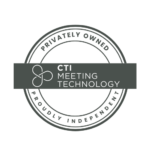Events are a great way to gather like-minded individuals, educate them on a specific topic, generate leads, and promote your products and services. However, organizing and managing an event consists of many moving pieces and often means a high cost for organizers. You invest resources, people, and a lot of time into your meetings, and you want to ensure that you are getting back more than you are giving. Making sure that the benefits outweigh the costs is essential to proving the success of your meetings. The most reliable way to do this is by measuring the event’s return on investment, also known as ROI.
Measuring ROI not only helps organizers in deciding if the event was worth it or not but also provides insights into how attendees engage with the event and identifies areas for improvement.
Calculating ROI seems simple: define how much you spent on this event and how much money you made from it in the end. But the truth is, there are many more metrics you can track so you gain much more valuable information than just a number. With the right tools, this task can be completed seamlessly and efficiently after the event.
Keep reading to discover how to calculate your event’s ROI and which metrics you should be looking at to attract valuable leads.
Understanding Event ROI
Event ROI is defined as the return on investment you see after hosting an event – that is, how much more you get compared to what you invested. But this doesn’t only mean money! Also think about all the time spent organizing every part of the event, and all the people that worked hard towards meeting the deadlines. The sum of these parts can’t be greater than what you got from running your event.
Did you earn back more money than you invested? Did the event bring new valuable leads? Did you benefit from high attendee engagement during the meeting?
It is crucial to analyze event ROI because it gives you a clear picture of the event’s profitability through clear data. You can then use this data to make better-informed decisions and run more successful meetings in the future.
Calculating event revenue is just one part of ROI. Take the list of all the goals you had when planning this meeting and evaluate how well you reached them. Here are some examples of event goals:
- Increased attendee engagement and knowledge.
- Generate relevant leads.
- Foster networking and community building within the industry.
- Increased brand awareness among your target audience.
- Media coverage.
While all these goals may be helpful for your organization, keep in mind what your participants are expecting from attending your event. Most of them value connection opportunities and being able to learn from industry peers and experts. In fact, a recent study conducted by the International Association of Exhibitions and Events shows that 75% of the nearly 9,000 participants surveyed mentioned networking as a primary factor influencing their decision to attend a conference or event. At the end of the day, attendee satisfaction will be a great factor in determining whether your meeting was a success and will encourage them to come back every year.
In short, determine non-monetary goals for your event that align with your attendees’ preferences and your overall business objectives. This step will help you get a better understanding of your event’s overall ROI.
When it comes to virtual or hybrid events, measuring ROI is not so different from onsite ones! In fact, engagement metrics are much easier to measure in the virtual realm. For example, you can measure unique views per presentation, how many minutes each participant watched, how many of them used the chat feature, etc.
Make sure that your software provider of choice offers detailed statistics and reports that you can use to understand the virtual event’s success. As a rule of thumb, if you are able to keep attendees engaged, event ROI is almost guaranteed!
Key Event metrics
Once you define the goals and objectives that are important for your meeting, you need to come up with a list of metrics to quantify their success.
Revenue metrics
Revenue metrics are key for measuring your event’s ROI. It provides exact results about everything you have sold related to the meeting. This includes registration tickets, exhibition booths and sponsor stands sold, merch sold, etc. Really anything your organization sold as part of the event counts as revenue!
Event sponsorship metrics
Sponsorships are an important part of successful events, bringing additional financial means for your event and providing connections for your participants. Finding good sponsors is not easy, so once they’re on board, you want to make sure that they will come back in the future.
Gathering sponsorship-based metrics can be essential to get sponsors to come back every year, and also to acquire new ones. Choose a meeting software that provides reliable metrics such as sponsor banner clicks and conversion rate. These numbers highlight the exposure exhibitors and sponsors received from the audience – your sponsor’s ROI.
Attendee engagement metrics
Delve into session analytics to figure out which specific sessions and topics gained your attendees’ attention. This data will help you craft a more audience-tailored event program in the future. If you are using interactivity tools such as polling, take a look at the analytics to decide which tools performed better. Gather the number of participants, live responses, and chat messages. This will not only give you an idea of the tool preferred by your audience but will also help you decide which sessions and topics are more popular.
Event satisfaction metrics
Having a high engagement rate during the event usually means that your audience is enjoying a satisfying experience. However, there are more ways you can measure attendee satisfaction. Providing a post-event survey to gather their feedback and opinions is a tried and true method. You can also take a look at social media to find mentions for your event’s hashtag or organization and go through past lists of attendees to identify repeated registrations.
Event marketing metrics
Promoting a new event takes a lot of time and effort – and money! – so it is mandatory to check whether the meeting was worth it! Event marketing metrics you should measure include:
- Website conversion rate: The number of visits to your event’s website and how many of them converted into registrants. Then measure this number against the number of actual attendees.
- Social media conversion rate: Likes, followers, impressions… compare these numbers to the registration number.
- Email conversion rate: Compare click rate to registrant rate.
- Monitor the number of new and return registrants.
Measuring and calculating ROI
All you need to calculate financial ROI is a simple formula. This number will help you determine if your event made a profit. In general, revenue comes from ticket sales, so calculating event ROI is easy: add the total revenue generated by sales minus the cost of the event to obtain the profit, and then divide it once again by the total cost of the event.
[(Total Revenue – Total Cost of the Event) ÷ Total Cost of Event] = Event ROI
This formula is really all you need to calculate the success of your event from a monetary perspective. The closer the result is to 100%, the better! But as we have pointed out earlier, there are many more factors that play into consideration and influence your event’s profitability.
Calculating non-monetary ROI
To get the full overview of your event’s success, it is important to calculate ROI for every component, not just the financials! Focus on engagement metrics to identify the most popular sessions and topics, and don’t forget to look at social media and email statistics to compare with actual registration dates.
In general, you want attendees to return to future events. Track new and returning attendants compared to past events. If the majority of your attendees are new, this could mean that people lose interest after your first event. Maybe you need to create more expectations for future events with more marketing material or a bigger social media presence. Or perhaps the topics covered this time were not relevant to your target audience.
Oftentimes, there is no universal way to measure these factors. It depends on which tools you are using and your goals. The key is not to overlook these aspects, get as much feedback as possible, and try to improve for future meetings. Your attendee satisfaction – and event ROI – depends on it!
Let’s Recap…
Now that you understand the importance of measuring ROI and which metrics to focus on, it is time to display everything in a detailed report for stakeholders:
- Define goals and KPIs: List your goals and objectives for the event. Your report should revolve around these predetermined goals and how well you were able to achieve them.
- Revenue report: You might need to justify your monetary decisions to your organization’s financial team and other stakeholders. Compare your event budget to what was actually earned from the event. Identify those areas that would have benefited from more budget, and those that were more successful than expected.
- Attendee satisfaction: Gather as much information as you can regarding attendee engagement and satisfaction. Take a look at session statistics, social media, and post-event feedback to identify patterns and topics of interest that your organization can leverage in the future.
As for the format chosen, there is really no rule! You can choose a basic Word document, or craft a more compelling PowerPoint presentation to display your insights. The key is to clearly measure the overall success of your event and identify interesting areas for improvement. This report can serve as a reference to organize future events, but also as a tool to attract sponsors and collaborators!
Check out CTI’s software solutions, including detailed lead generation statistics that you can use to effectively measure your event’s ROI.





